外研版(2019)必修 第一册Unit 1 A new start Using language课件(共43张PPT)
文档属性
| 名称 | 外研版(2019)必修 第一册Unit 1 A new start Using language课件(共43张PPT) | 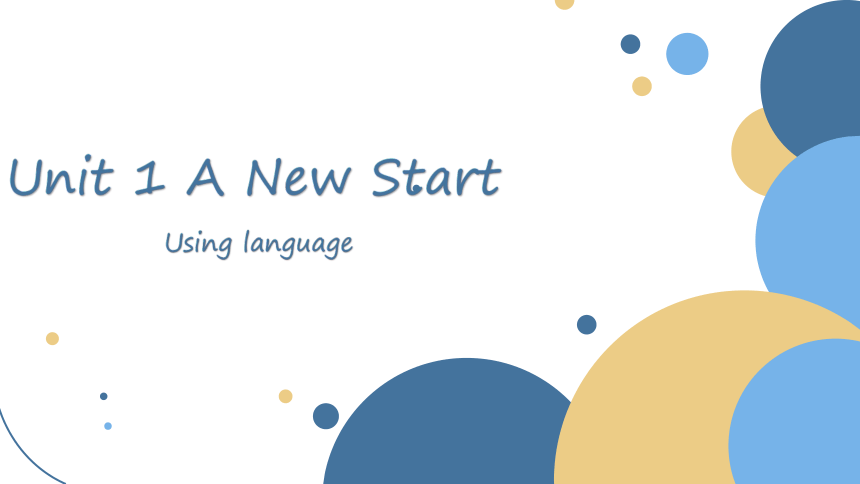 | |
| 格式 | pptx | ||
| 文件大小 | 2.9MB | ||
| 资源类型 | 教案 | ||
| 版本资源 | 外研版(2019) | ||
| 科目 | 英语 | ||
| 更新时间 | 2023-10-23 18:36:47 | ||
图片预览

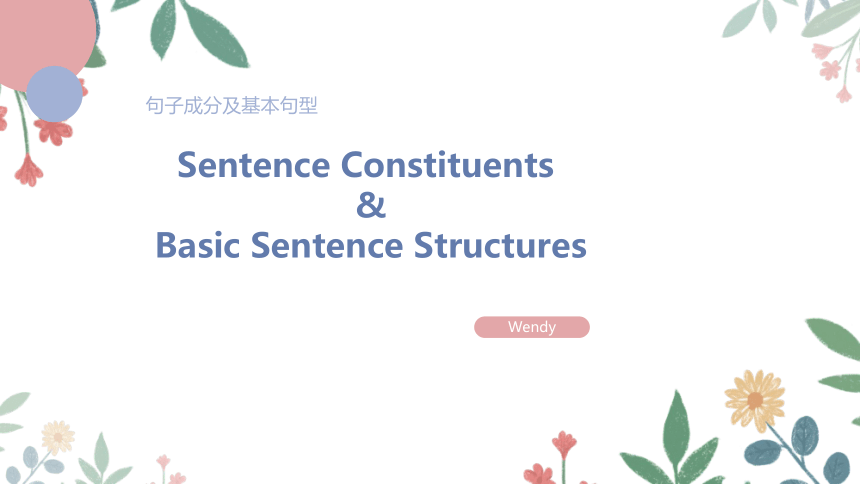
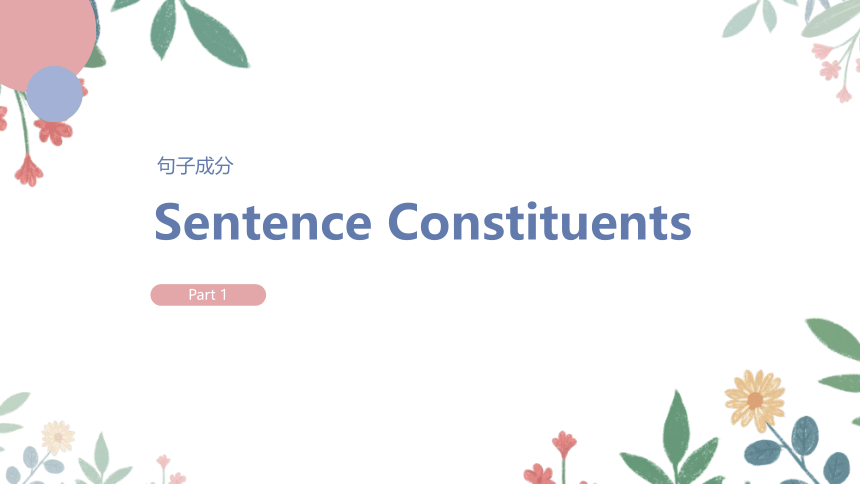
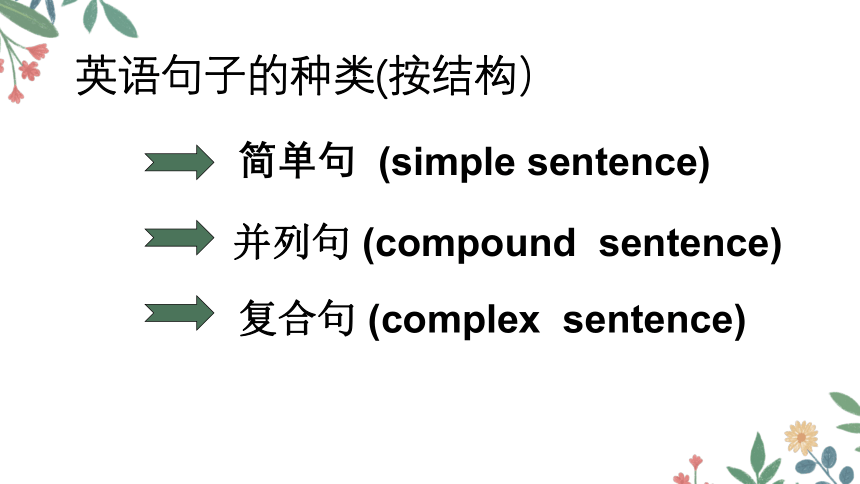

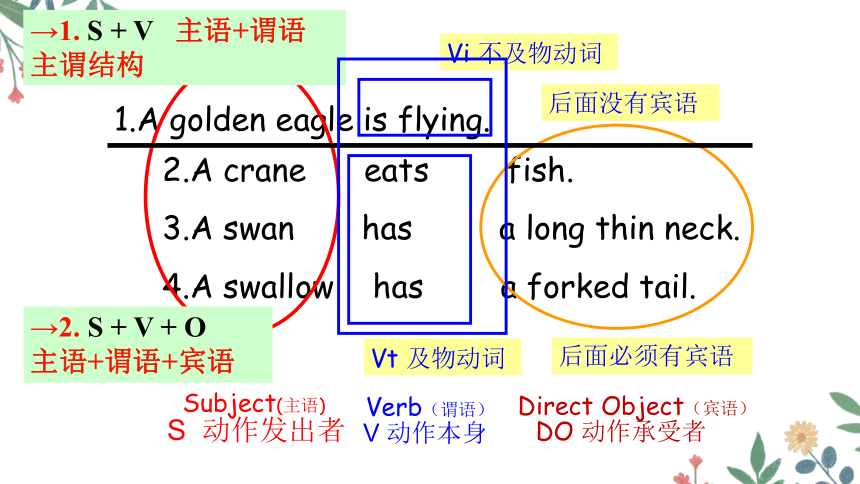
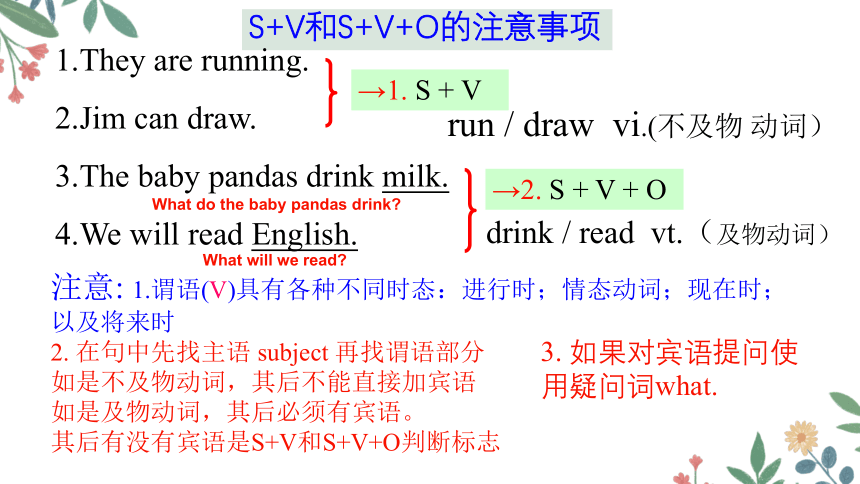

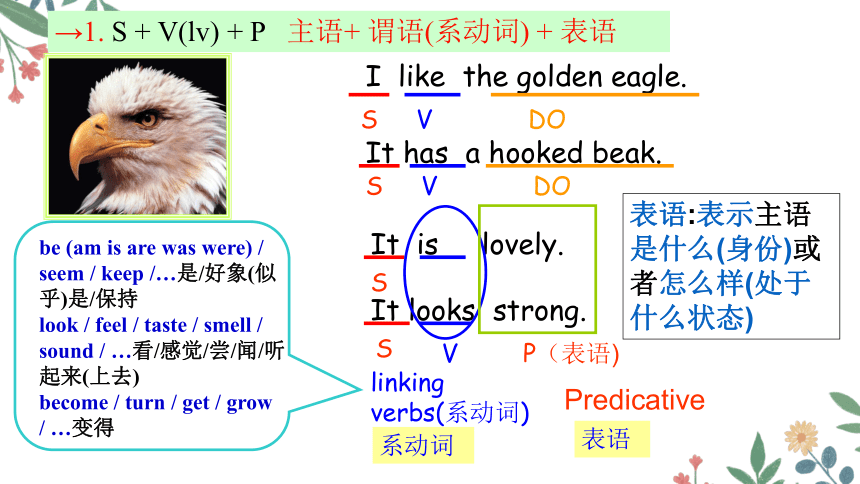
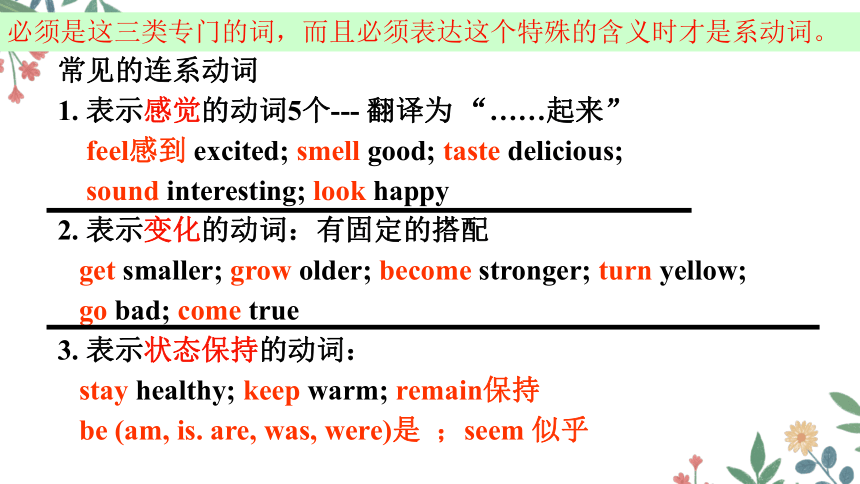
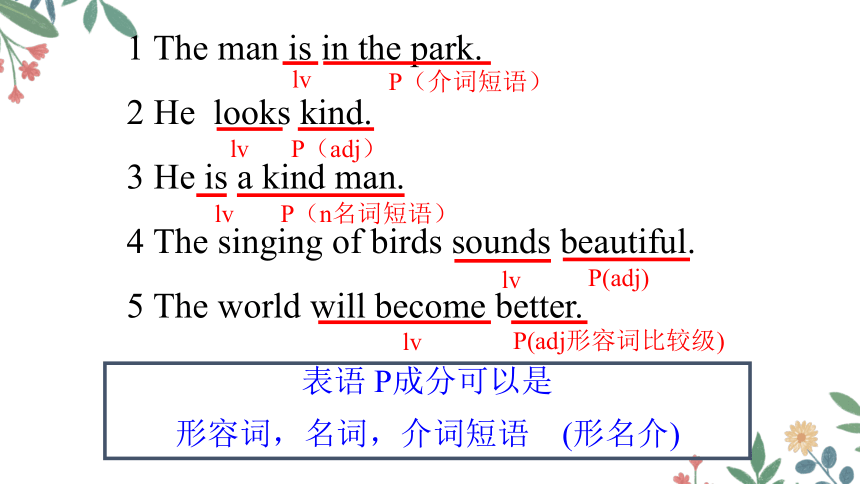
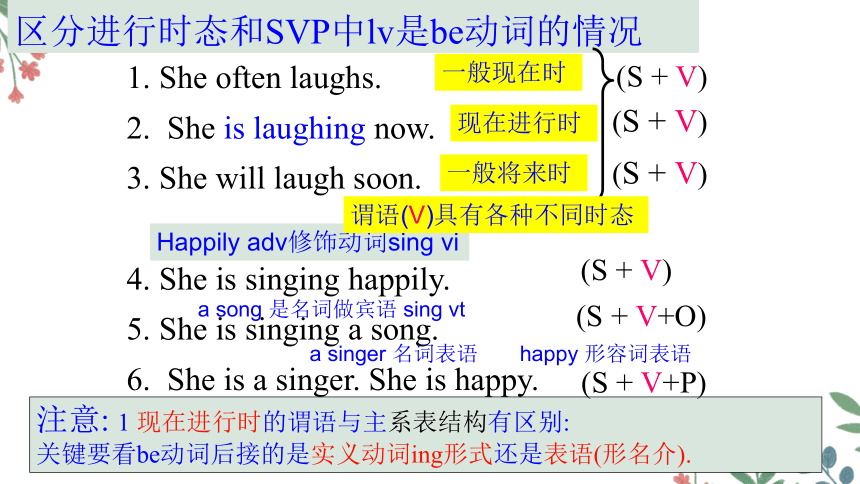
文档简介
(共43张PPT)
Unit 1 A New Start
Using language
Sentence Constituents
&
Basic Sentence Structures
Wendy
句子成分及基本句型
Sentence Constituents
Part 1
句子成分
英语句子的种类(按结构)
简单句 (simple sentence)
并列句 (compound sentence)
复合句 (complex sentence)
主语
谓语
宾语
宾语
宾补
表语
宾语(间)
宾语(直)
Vt(及物动词)
系动词
Vi(不及物动词)
英语句子基本成分示意图
简单句(Simple Sentences) 就是只包含一个主谓结构的句子。
英语中千变万化的句子归根结底都是由简单句的五种基本句型组合、扩展、变化而来的,只要把这些基本句型弄清楚,你就会游刃有余了。
2.A crane eats fish.
3.A swan has a long thin neck.
4.A swallow has a forked tail.
1.A golden eagle is flying.
Subject(主语)
S 动作发出者
Verb(谓语)
V 动作本身
Direct Object(宾语)
DO 动作承受者
→1. S + V 主语+谓语 主谓结构
→2. S + V + O 主语+谓语+宾语
Vi 不及物动词
后面没有宾语
Vt 及物动词
后面必须有宾语
S+V和S+V+O的注意事项
1.They are running.
2.Jim can draw.
3.The baby pandas drink milk.
4.We will read English.
run / draw vi.(不及物 动词)
drink / read vt.(及物动词)
注意: 1.谓语(V)具有各种不同时态:进行时;情态动词;现在时; 以及将来时
2. 在句中先找主语 subject 再找谓语部分
如是不及物动词,其后不能直接加宾语
如是及物动词,其后必须有宾语。
其后有没有宾语是S+V和S+V+O判断标志
→1. S + V
→2. S + V + O
What do the baby pandas drink
What will we read
3. 如果对宾语提问使用疑问词what.
1. 动词 + to do: learn / prepare / would like / need / have / try /
want / hope / plan / agree / choose / decide
这就是我们常见的 动词+ to do 句型
2. 动词 + doing sth: mind / finish / practise
这就是我们常见的 动词+ doing 句型
3. 动词 + 宾语从句: think / believe/ be sure / be afraid /say / know / find
The government wants to protect the endangered birds.
S
V
O
I will finish doing homework soon.
S
V
O
I think that you can do the job.
S
V
O
I like the golden eagle.
It has a hooked beak.
It looks strong.
It is lovely.
S
S
S
S
V
V
linking verbs(系动词)
DO
DO
P(表语)
Predicative
V
→1. S + V(lv) + P 主语+ 谓语(系动词) + 表语
系动词
表语
表语:表示主语是什么(身份)或者怎么样(处于什么状态)
be (am is are was were) / seem / keep /…是/好象(似乎)是/保持
look / feel / taste / smell / sound / …看/感觉/尝/闻/听起来(上去)
become / turn / get / grow / …变得
常见的连系动词
1. 表示感觉的动词5个--- 翻译为 “……起来”
feel感到 excited; smell good; taste delicious;
sound interesting; look happy
2. 表示变化的动词:有固定的搭配
get smaller; grow older; become stronger; turn yellow;
go bad; come true
3. 表示状态保持的动词:
stay healthy; keep warm; remain保持
be (am, is. are, was, were)是 ;seem 似乎
必须是这三类专门的词,而且必须表达这个特殊的含义时才是系动词。
1 The man is in the park.
2 He looks kind.
3 He is a kind man.
4 The singing of birds sounds beautiful.
5 The world will become better.
lv
lv
lv
lv
lv
P(介词短语)
P(adj)
P(adj)
P(n名词短语)
P(adj形容词比较级)
表语 P成分可以是
形容词,名词,介词短语 (形名介)
She often laughs.
2. She is laughing now.
3. She will laugh soon.
4. She is singing happily.
She is singing a song.
She is a singer. She is happy.
(S + V+O)
(S + V)
(S + V)
(S + V)
(S + V)
区分进行时态和SVP中lv是be动词的情况
注意: 1 现在进行时的谓语与主系表结构有区别:
关键要看be动词后接的是实义动词ing形式还是表语(形名介).
(S + V+P)
Happily adv修饰动词sing vi
a song 是名词做宾语 sing vt
a singer 名词表语 happy 形容词表语
一般现在时
现在进行时
一般将来时
谓语(V)具有各种不同时态
We call the man “David”.
a zookeeper
S
V
DO
OC(宾补)
Object Complement
S
V
DO
OC
S
V
DO
OC
I make him angry.
He tells us to protect the birds.
David
S + V + DO + OC 主 +谓 + 宾+宾补
We call
the man
David
DO
OC
1 仅仅使用主谓宾无法说明完整句意
必须添加补足语补充说明宾语情况
判断标准是在DO和OC中间可否加be动词
S + V + DO + OC 主 +谓 + 宾+宾补句型
the man
is
就是是否存在逻辑上的主系表关系
David
此处为 名词作宾补
可接名词宾补的动词有call / elect / name / find…
I make
him
angry
DO
OC
1 仅仅使用主谓宾无法说明完整句意
必须添加补足语补充说明宾语情况
判断标准是在DO和OC中间可否加be动词
主 +谓 + 宾+宾补句型 简称 主谓宾宾补
He
is
就是是否存在
逻辑上的主系表关系
此处为 形容词作宾补
可接形容词宾补的动词有keep / make / find…
angry
We often find
him
in the zoo
DO
OC
1 仅仅使用主谓宾无法说明完整句意
必须添加补足语补充说明宾语情况
判断标准是在DO和OC中间可否加be动词
主 +谓 + 宾+宾补句型 简称 主谓宾补
He
is
就是是否存在
逻辑上的主系表关系
此处为 介短作宾补
可接 介短宾补的动词有keep / see / notice / find…
in the zoo
He tells
us
to protect the birds
DO
OC
1 仅仅使用主谓宾无法说明完整句意
必须添加补足语补充说明宾语情况
就是我们常见的 动词+ sb + to do 词组
主 +谓 + 宾+宾补句型 简称 主谓宾补
此处为 带to的动词不定式做宾补
He tells us to protect the birds.
常见的可接带to不定式宾补的动词有:
tell, ask, want, would like, wish, teach, invite…
V + O + OC (V sb to do sth)
My deskmate often makes me laugh.
常见的可接不带to不定式当宾补的动词有:
一感二听三让五看” feel,/ hear, listen to, / let, make, have, /look at, see, , watch, notice, observe
V + O + OC (V sb do sth)
He keeps me waiting.
常见的可接动词-ing形式作宾补的动词有:
keep 和 see, hear, feel, watch, find…
V + O + OC (V sb doing sth)
I often hear David sing when I stay at home, but yesterday I was very angry because I heard him singing in his room at midnight.
感官类动词用动词原形和动词-ing形式做宾补、含义不同
Can you hear someone playing basketball next door
V sb doing sth
He spoke loudly to make himself heard.
常见的可接动词-ed形式作宾补的动词有:
have, make, get, see, hear, feel, watch, find…
V + O + OC (V sb done)
He came home at midnight and found his money stolen.
V sb done
1 I find you clever.
2 We will make our country stronger and stronger.
3 They can keep the zoo clean.
4 Parents wish their children to study hard.
5 We often make the teachers help us.
DO
DO
DO
DO
DO
OC (adj)
OC 形容词 比较级
OC adj
OC to do 不定式
OC 动词原形
常考的主谓宾补句型:
一个非常特殊的句型
I found it interesting to learn English.
S
V
DO
OC
DO
形式宾语
真正宾语
动词(make / feel / find / consider / think)+ it + 宾补 + 真正宾语
I felt it useful to learn English.
we can give some food.
the birds
S
V
DO(直接宾语) Direct object
IO(间接宾语)
Indirect Object
He tells me some rules.
IO
V
S
DO
sb.
Sth.
S + V + IO + DO 主 +谓 + 间宾+直宾句型
I pass
He bought
him
a book
his son
a present.
IO
DO
IO
DO
to
for
双宾语结构中有两个宾语,判断标准是
可否将两个宾语顺序替换并加介词to/for
S + V + IO + DO 主语+谓语+直接宾语+间接宾语
加to: bring / give / offer / pass/ show / sell / tell / send / lend /
return / hand
加for: buy / choose / draw / make / order / paint / sing / save
3. Many boys are running.
1. I feel excited.
4. He gave Tom a present.
5. I find it interesting.
6. Music sounds beautiful.
7. I am a student.
8. She bought a pen for me.
9. I saw her dance.
2. They are watching TV.
主语+ 谓语(系动词) + 表语
主语+谓语(及)+宾语
主语+谓语(不及物)
主 +谓 + 间宾+直宾
主 +谓 + 宾+宾补
主语+ 谓语(系动词) + 表语
主语+ 谓语(系动词) + 表语
主 +谓 + 间宾+直宾句型
主 +谓 + 宾+宾补
10. I call him LiHua.
主 +谓 + 宾+宾补
说出句子所属的基本句型
11. She spoke very softly.
12. He bought a T-shirt.
13. Jay named his dog Bobby.
14. She looks lovely.
主语+谓语(不及物)
主语+谓语(及)+宾语
主 +谓 + 宾+宾补
主语+ 谓语(系动词) + 表语
常考的主谓宾补句型:请找出宾补
1 We name our city Yangzhou.
2 The students make Daniel monitor.
3 Everyone should make the classroom clean.
4 Millie found the movie very interesting.
5 I left the book at home.
6 They finally found the pen under the book.
7 My teacher let the boy stand an hour.
8 I heard him sing a song last night.
9 I watch our team playing football.
10 I heard him singing at 12 last night.
11 My mother keeps me waiting an hour.
12 We saw Kitty dancing at that moment.
13 I would like/want you to do a bird count.
14 Mr. Tang teaches me how to read a book.
练习:下列句子分别属于哪一基本句型
A . 主语+系动词+表语 B . 主语+谓语
C .主语+谓语+宾语
D .主语+谓语+间接宾语+直接宾语
E .主语+谓语+宾语+宾语补足语
( )1. The flower smells sweet .
( )2. I visited my teacher last Sunday .
( )3. They are dancing .
( )4. Mrs. Black helped his son brush his teeth .
( )5. Jenny bought a watch for him.
( )6. His mother sent him a new watch .
( )7. I often hear her sing in the next room.
( )8. The girl opened the door .
( )9. Mary and Lynn live in Taiyuan .
( )10. She looks delighted.
( )11. You should study hard .
( )12. The children play football on the playground.
A . 主语+系动词+表语 B . 主语+谓语 C .主语+谓语+宾语
D .主语+谓语+间接宾语+直接宾语
E .主语+谓语+宾语+宾语补足语
易考的混淆点 一
The food tastes _____________.
S + V(lv) + P
I will taste the food _______ .
S + V(Vt) + O
His father looked ________ .
S+V(lv) + P
His father looked __________ (angry) at him.
S + V(Vi+介词) + O
delicious
well
angry
angrily
译为“……起来”系动词。
有的词既可做实义动词也可做系动词(taste)。
不及物/及物动词
易考的混淆点 二
1 The food tastes _______.
A good B well
2 We should stay ________ during the earthquake.
A calm B calmly
3 The young boy becomes _________.
A more and more surprised adj
B more and more surprisedly adv
C more and more surprise n
good
calm
A
只有形容词、名词、介词短语才能做系动词后面的表语,要根据含义上确定动词是不是系动词。
Review:
Basic sentence structures
Activity 1
a He was friendly.
b The exam made me quite nervous.
c I passed him a book.
d She agreed.
e He wrote a long letter.
f He talked loudly.
g She looked after her sister patiently.
1 I saw a white-haired man.
2 I replied.
3 He gave me a smile.
4 I breathed deeply.
5 I looked at them in panic.
6 I was embarrassed.
7 His words made me a lot more relaxed!
e
d
c
f
g
a
b
Match the sentences that share the same structures.
Look at the pictures and tell the story with your own ending. See how many different basic sentence structures you can use.
Activity 2 Page 5
A boy (Tom)was playing basketball in the classroom.
(SVOA)
What was the boy doing
Activity 2
Tom Kate
1. Tom was playing basketball in the classroom. (S V O A)
2. The ball hit Kate’s MP3 accidentally.
(S V O A)
3. It would make Kate very angry. (S V O OC)
Tom broke Kate’s MP3 accidentally, and it would make Kate very angry. (并列句)
Tom broke Kate’s MP3 accidentally , which would make Kate very angry. (定从)
What would Kate feel
The broken MP3 would make Kate very angry.
(S V O OC)
Kate would be angry.
(S V P)
Listen to the conversation and decide what the speakers are mainly talking about.
Making a plan
Activity 5
The clubs they have joined and the activities they do after school.
The things they should do to manage their time well.
The challenges they face in their new school.
Activity 6
Listen again and complete the plan.
List
the time (it takes)
do one thing
important things
Activity 7
Work in pairs. Act out the conversation to discuss ideas for a weekend study plan for English.
Student A: Turn to Page 81.
Student B: Turn to Page 84.
Activity 8
Work in pairs. Make another weekend plan and have a similar conversation.
基本句型:
一、主谓 SV
二、主(系)表 SP
三、主谓宾 SVO
四、主谓宾宾 SVOO
五、主谓宾补 SVOC
六、主谓状 SVA
七、主谓宾状 SVOA
Ⅰ. Read the sentences and analyze the
structures.
1. I’m not out-going.
2. The teacher was kind and friendly.
3. He told a funny story.
4. Everyone laughed.
5. I found most of my classmates and teachers friendly and helpful.
6. I didn’t feel awkward or frightened.
7. He told us funny stories.
SVOO
SP
SVOC
SV
SVO
SP
SP
8. I couldn’t concentrate on the experiment.
9. I felt much more confident.
10. I want to make a good first impression.
11. Tomorrow will be great.
12. We had our chemistry class in the science lab.
SVO
SP
SVO
SP
SVOA
Unit 1 A New Start
Using language
Sentence Constituents
&
Basic Sentence Structures
Wendy
句子成分及基本句型
Sentence Constituents
Part 1
句子成分
英语句子的种类(按结构)
简单句 (simple sentence)
并列句 (compound sentence)
复合句 (complex sentence)
主语
谓语
宾语
宾语
宾补
表语
宾语(间)
宾语(直)
Vt(及物动词)
系动词
Vi(不及物动词)
英语句子基本成分示意图
简单句(Simple Sentences) 就是只包含一个主谓结构的句子。
英语中千变万化的句子归根结底都是由简单句的五种基本句型组合、扩展、变化而来的,只要把这些基本句型弄清楚,你就会游刃有余了。
2.A crane eats fish.
3.A swan has a long thin neck.
4.A swallow has a forked tail.
1.A golden eagle is flying.
Subject(主语)
S 动作发出者
Verb(谓语)
V 动作本身
Direct Object(宾语)
DO 动作承受者
→1. S + V 主语+谓语 主谓结构
→2. S + V + O 主语+谓语+宾语
Vi 不及物动词
后面没有宾语
Vt 及物动词
后面必须有宾语
S+V和S+V+O的注意事项
1.They are running.
2.Jim can draw.
3.The baby pandas drink milk.
4.We will read English.
run / draw vi.(不及物 动词)
drink / read vt.(及物动词)
注意: 1.谓语(V)具有各种不同时态:进行时;情态动词;现在时; 以及将来时
2. 在句中先找主语 subject 再找谓语部分
如是不及物动词,其后不能直接加宾语
如是及物动词,其后必须有宾语。
其后有没有宾语是S+V和S+V+O判断标志
→1. S + V
→2. S + V + O
What do the baby pandas drink
What will we read
3. 如果对宾语提问使用疑问词what.
1. 动词 + to do: learn / prepare / would like / need / have / try /
want / hope / plan / agree / choose / decide
这就是我们常见的 动词+ to do 句型
2. 动词 + doing sth: mind / finish / practise
这就是我们常见的 动词+ doing 句型
3. 动词 + 宾语从句: think / believe/ be sure / be afraid /say / know / find
The government wants to protect the endangered birds.
S
V
O
I will finish doing homework soon.
S
V
O
I think that you can do the job.
S
V
O
I like the golden eagle.
It has a hooked beak.
It looks strong.
It is lovely.
S
S
S
S
V
V
linking verbs(系动词)
DO
DO
P(表语)
Predicative
V
→1. S + V(lv) + P 主语+ 谓语(系动词) + 表语
系动词
表语
表语:表示主语是什么(身份)或者怎么样(处于什么状态)
be (am is are was were) / seem / keep /…是/好象(似乎)是/保持
look / feel / taste / smell / sound / …看/感觉/尝/闻/听起来(上去)
become / turn / get / grow / …变得
常见的连系动词
1. 表示感觉的动词5个--- 翻译为 “……起来”
feel感到 excited; smell good; taste delicious;
sound interesting; look happy
2. 表示变化的动词:有固定的搭配
get smaller; grow older; become stronger; turn yellow;
go bad; come true
3. 表示状态保持的动词:
stay healthy; keep warm; remain保持
be (am, is. are, was, were)是 ;seem 似乎
必须是这三类专门的词,而且必须表达这个特殊的含义时才是系动词。
1 The man is in the park.
2 He looks kind.
3 He is a kind man.
4 The singing of birds sounds beautiful.
5 The world will become better.
lv
lv
lv
lv
lv
P(介词短语)
P(adj)
P(adj)
P(n名词短语)
P(adj形容词比较级)
表语 P成分可以是
形容词,名词,介词短语 (形名介)
She often laughs.
2. She is laughing now.
3. She will laugh soon.
4. She is singing happily.
She is singing a song.
She is a singer. She is happy.
(S + V+O)
(S + V)
(S + V)
(S + V)
(S + V)
区分进行时态和SVP中lv是be动词的情况
注意: 1 现在进行时的谓语与主系表结构有区别:
关键要看be动词后接的是实义动词ing形式还是表语(形名介).
(S + V+P)
Happily adv修饰动词sing vi
a song 是名词做宾语 sing vt
a singer 名词表语 happy 形容词表语
一般现在时
现在进行时
一般将来时
谓语(V)具有各种不同时态
We call the man “David”.
a zookeeper
S
V
DO
OC(宾补)
Object Complement
S
V
DO
OC
S
V
DO
OC
I make him angry.
He tells us to protect the birds.
David
S + V + DO + OC 主 +谓 + 宾+宾补
We call
the man
David
DO
OC
1 仅仅使用主谓宾无法说明完整句意
必须添加补足语补充说明宾语情况
判断标准是在DO和OC中间可否加be动词
S + V + DO + OC 主 +谓 + 宾+宾补句型
the man
is
就是是否存在逻辑上的主系表关系
David
此处为 名词作宾补
可接名词宾补的动词有call / elect / name / find…
I make
him
angry
DO
OC
1 仅仅使用主谓宾无法说明完整句意
必须添加补足语补充说明宾语情况
判断标准是在DO和OC中间可否加be动词
主 +谓 + 宾+宾补句型 简称 主谓宾宾补
He
is
就是是否存在
逻辑上的主系表关系
此处为 形容词作宾补
可接形容词宾补的动词有keep / make / find…
angry
We often find
him
in the zoo
DO
OC
1 仅仅使用主谓宾无法说明完整句意
必须添加补足语补充说明宾语情况
判断标准是在DO和OC中间可否加be动词
主 +谓 + 宾+宾补句型 简称 主谓宾补
He
is
就是是否存在
逻辑上的主系表关系
此处为 介短作宾补
可接 介短宾补的动词有keep / see / notice / find…
in the zoo
He tells
us
to protect the birds
DO
OC
1 仅仅使用主谓宾无法说明完整句意
必须添加补足语补充说明宾语情况
就是我们常见的 动词+ sb + to do 词组
主 +谓 + 宾+宾补句型 简称 主谓宾补
此处为 带to的动词不定式做宾补
He tells us to protect the birds.
常见的可接带to不定式宾补的动词有:
tell, ask, want, would like, wish, teach, invite…
V + O + OC (V sb to do sth)
My deskmate often makes me laugh.
常见的可接不带to不定式当宾补的动词有:
一感二听三让五看” feel,/ hear, listen to, / let, make, have, /look at, see, , watch, notice, observe
V + O + OC (V sb do sth)
He keeps me waiting.
常见的可接动词-ing形式作宾补的动词有:
keep 和 see, hear, feel, watch, find…
V + O + OC (V sb doing sth)
I often hear David sing when I stay at home, but yesterday I was very angry because I heard him singing in his room at midnight.
感官类动词用动词原形和动词-ing形式做宾补、含义不同
Can you hear someone playing basketball next door
V sb doing sth
He spoke loudly to make himself heard.
常见的可接动词-ed形式作宾补的动词有:
have, make, get, see, hear, feel, watch, find…
V + O + OC (V sb done)
He came home at midnight and found his money stolen.
V sb done
1 I find you clever.
2 We will make our country stronger and stronger.
3 They can keep the zoo clean.
4 Parents wish their children to study hard.
5 We often make the teachers help us.
DO
DO
DO
DO
DO
OC (adj)
OC 形容词 比较级
OC adj
OC to do 不定式
OC 动词原形
常考的主谓宾补句型:
一个非常特殊的句型
I found it interesting to learn English.
S
V
DO
OC
DO
形式宾语
真正宾语
动词(make / feel / find / consider / think)+ it + 宾补 + 真正宾语
I felt it useful to learn English.
we can give some food.
the birds
S
V
DO(直接宾语) Direct object
IO(间接宾语)
Indirect Object
He tells me some rules.
IO
V
S
DO
sb.
Sth.
S + V + IO + DO 主 +谓 + 间宾+直宾句型
I pass
He bought
him
a book
his son
a present.
IO
DO
IO
DO
to
for
双宾语结构中有两个宾语,判断标准是
可否将两个宾语顺序替换并加介词to/for
S + V + IO + DO 主语+谓语+直接宾语+间接宾语
加to: bring / give / offer / pass/ show / sell / tell / send / lend /
return / hand
加for: buy / choose / draw / make / order / paint / sing / save
3. Many boys are running.
1. I feel excited.
4. He gave Tom a present.
5. I find it interesting.
6. Music sounds beautiful.
7. I am a student.
8. She bought a pen for me.
9. I saw her dance.
2. They are watching TV.
主语+ 谓语(系动词) + 表语
主语+谓语(及)+宾语
主语+谓语(不及物)
主 +谓 + 间宾+直宾
主 +谓 + 宾+宾补
主语+ 谓语(系动词) + 表语
主语+ 谓语(系动词) + 表语
主 +谓 + 间宾+直宾句型
主 +谓 + 宾+宾补
10. I call him LiHua.
主 +谓 + 宾+宾补
说出句子所属的基本句型
11. She spoke very softly.
12. He bought a T-shirt.
13. Jay named his dog Bobby.
14. She looks lovely.
主语+谓语(不及物)
主语+谓语(及)+宾语
主 +谓 + 宾+宾补
主语+ 谓语(系动词) + 表语
常考的主谓宾补句型:请找出宾补
1 We name our city Yangzhou.
2 The students make Daniel monitor.
3 Everyone should make the classroom clean.
4 Millie found the movie very interesting.
5 I left the book at home.
6 They finally found the pen under the book.
7 My teacher let the boy stand an hour.
8 I heard him sing a song last night.
9 I watch our team playing football.
10 I heard him singing at 12 last night.
11 My mother keeps me waiting an hour.
12 We saw Kitty dancing at that moment.
13 I would like/want you to do a bird count.
14 Mr. Tang teaches me how to read a book.
练习:下列句子分别属于哪一基本句型
A . 主语+系动词+表语 B . 主语+谓语
C .主语+谓语+宾语
D .主语+谓语+间接宾语+直接宾语
E .主语+谓语+宾语+宾语补足语
( )1. The flower smells sweet .
( )2. I visited my teacher last Sunday .
( )3. They are dancing .
( )4. Mrs. Black helped his son brush his teeth .
( )5. Jenny bought a watch for him.
( )6. His mother sent him a new watch .
( )7. I often hear her sing in the next room.
( )8. The girl opened the door .
( )9. Mary and Lynn live in Taiyuan .
( )10. She looks delighted.
( )11. You should study hard .
( )12. The children play football on the playground.
A . 主语+系动词+表语 B . 主语+谓语 C .主语+谓语+宾语
D .主语+谓语+间接宾语+直接宾语
E .主语+谓语+宾语+宾语补足语
易考的混淆点 一
The food tastes _____________.
S + V(lv) + P
I will taste the food _______ .
S + V(Vt) + O
His father looked ________ .
S+V(lv) + P
His father looked __________ (angry) at him.
S + V(Vi+介词) + O
delicious
well
angry
angrily
译为“……起来”系动词。
有的词既可做实义动词也可做系动词(taste)。
不及物/及物动词
易考的混淆点 二
1 The food tastes _______.
A good B well
2 We should stay ________ during the earthquake.
A calm B calmly
3 The young boy becomes _________.
A more and more surprised adj
B more and more surprisedly adv
C more and more surprise n
good
calm
A
只有形容词、名词、介词短语才能做系动词后面的表语,要根据含义上确定动词是不是系动词。
Review:
Basic sentence structures
Activity 1
a He was friendly.
b The exam made me quite nervous.
c I passed him a book.
d She agreed.
e He wrote a long letter.
f He talked loudly.
g She looked after her sister patiently.
1 I saw a white-haired man.
2 I replied.
3 He gave me a smile.
4 I breathed deeply.
5 I looked at them in panic.
6 I was embarrassed.
7 His words made me a lot more relaxed!
e
d
c
f
g
a
b
Match the sentences that share the same structures.
Look at the pictures and tell the story with your own ending. See how many different basic sentence structures you can use.
Activity 2 Page 5
A boy (Tom)was playing basketball in the classroom.
(SVOA)
What was the boy doing
Activity 2
Tom Kate
1. Tom was playing basketball in the classroom. (S V O A)
2. The ball hit Kate’s MP3 accidentally.
(S V O A)
3. It would make Kate very angry. (S V O OC)
Tom broke Kate’s MP3 accidentally, and it would make Kate very angry. (并列句)
Tom broke Kate’s MP3 accidentally , which would make Kate very angry. (定从)
What would Kate feel
The broken MP3 would make Kate very angry.
(S V O OC)
Kate would be angry.
(S V P)
Listen to the conversation and decide what the speakers are mainly talking about.
Making a plan
Activity 5
The clubs they have joined and the activities they do after school.
The things they should do to manage their time well.
The challenges they face in their new school.
Activity 6
Listen again and complete the plan.
List
the time (it takes)
do one thing
important things
Activity 7
Work in pairs. Act out the conversation to discuss ideas for a weekend study plan for English.
Student A: Turn to Page 81.
Student B: Turn to Page 84.
Activity 8
Work in pairs. Make another weekend plan and have a similar conversation.
基本句型:
一、主谓 SV
二、主(系)表 SP
三、主谓宾 SVO
四、主谓宾宾 SVOO
五、主谓宾补 SVOC
六、主谓状 SVA
七、主谓宾状 SVOA
Ⅰ. Read the sentences and analyze the
structures.
1. I’m not out-going.
2. The teacher was kind and friendly.
3. He told a funny story.
4. Everyone laughed.
5. I found most of my classmates and teachers friendly and helpful.
6. I didn’t feel awkward or frightened.
7. He told us funny stories.
SVOO
SP
SVOC
SV
SVO
SP
SP
8. I couldn’t concentrate on the experiment.
9. I felt much more confident.
10. I want to make a good first impression.
11. Tomorrow will be great.
12. We had our chemistry class in the science lab.
SVO
SP
SVO
SP
SVOA
